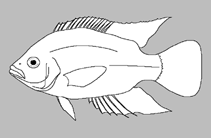Carregue seu(sua) Fotos e vídeos
Pictures | Imagem do GoogleNo image available for this species;
drawing shows typical species in Cichlidae.
Pictures | Imagem do GoogleNo image available for this species;
drawing shows typical species in Cichlidae.
Common names from other countries
Classificação / Names Nomes comuns | Sinônimos | Catalog of Fishes(Gênero, Espécies) | ITIS | CoL | WoRMS | Cloffa
> Cichliformes (Cichlids, convict blennies) > Cichlidae (Cichlids) > Pseudocrenilabrinae
Etymology: kumwera: The name kumwera means 'south' in Chichewa, alluding to the species' distribution in the southern part of Lake Malawi, and it is used as a noun in apposition (Ref. 119465).
Etymology: kumwera: The name kumwera means 'south' in Chichewa, alluding to the species' distribution in the southern part of Lake Malawi, and it is used as a noun in apposition (Ref. 119465).
Environment: milieu / climate zone / depth range / distribution range Ecologia
; Água doce bentopelágico. Tropical
Distribuição Países | Áreas da FAO | Ecossistemas | Ocorrências | Point map | Introduções | Faunafri
Africa: Lake Malawi in Malawi (Ref. 119465).
Tamanho / Peso / Idade
Descrição suscinta Chaves de identificação | Morfologia | Morfometria
Espinhos dorsais (total) : 17 - 19; Raios dorsais (total) : 8 - 10; Espinhos anais: 3; Raios anais : 7 - 8. Diagnosis: The steeply-sloped vomer without a swollen rostral tip, a small mouth, retrognathic jaws, and the presence of bicuspid teeth in the outer rows of the oral jaws and enlarged conical teeth at the back of the jaws place this species in Tropheops (Ref. 119465). Tropheops kumwera, body depth 23.6-31.0% of standard length, cannot reliably be distinguished from other Tropheops in body depth, 26.6-34.5% of standard length; it does have relatively smaller eye than other Tropheops, horizontal eye diameter 25.8-32.6% of head length and vertical eye diameter 24.2-31.4% of head length vs. 31.2-43.8% and 29.9-43.3% respectively, except T. kamtambo with 26.3-30.2% and 24.0-29.7% respectively (Ref. 119465). It can often be distinguished from T. kamtambo by a shallower head depth than in T. kamtambo, head depth 70.2-84.5% of head length vs. 79.4-97.1%; males of T. kumwera in territorial colour are distinguished from those of T. biriwira by their blue ground colouration and a blue dorsal fin, which are olive green/light blue and yellow-green in T. biriwira respectively; breeding male T. kumwera usually exhibit only the first 3-4 flank bars while male T. kamtambo exhibit all 9-10 bars; female T. kumwera lack a submarginal band in the dorsal fin which is present in female T. kamtambo (Ref. 119465).
Ciclo de vida ou comportamento de acasalamento Maturidade | Reprodução | Desova | Ovos | Fecundidade | Larvas
Referência principal
Upload your references | Referências | Coordenador : Kullander, Sven O. | Colaboradores
Li, S., A.F. Konings and J.R. Stauffer Jr., 2016. A revision of the Pseudotropheus elongatus species group (Teleostei: Cichlidae) with description of a new genus and seven new species. Zootaxa 4168(2):353-381. (Ref. 119465)
Status na Lista Vermelha da UICN (Ref. 130435: Version 2024-2)
Quase ameaçada (NT) (B1a+2a); Date assessed: 19 June 2018
Ameaça para os humanos
Harmless
Uso pelos humanos
FAO(Publication : search) | FIRMS (Stock assessments) | FishSource |
Mais informação
Trophic ecology
Itens alimentares
Composição da dieta
Consumo alimentar
Food rations
Predadores
Itens alimentares
Composição da dieta
Consumo alimentar
Food rations
Predadores
Ecology
Ecologia
Home ranges
Ecologia
Home ranges
Population dynamics
Parâmetros de crescimento
Max. ages / sizes
Length-weight rel.
Length-length rel.
Frequências de comprimento
Conversão de massa
Recrutamento
Abundância
Parâmetros de crescimento
Max. ages / sizes
Length-weight rel.
Length-length rel.
Frequências de comprimento
Conversão de massa
Recrutamento
Abundância
Life cycle
Reprodução
Maturidade
Fecundidade
Desova
Spawning aggregations
Ovos
Desenvolvimento dos ovos
Larvas
Dinâmica larval
Reprodução
Maturidade
Fecundidade
Desova
Spawning aggregations
Ovos
Desenvolvimento dos ovos
Larvas
Dinâmica larval
Anatomy
Área branquial
Brain
Otolith
Área branquial
Brain
Otolith
Physiology
Body composition
Nutrients
Consumo de oxigênio
Tipo de natação
Velocidade de natação
Visual pigments
Fish sound
Diseases & Parasites
Toxicity (LC50s)
Body composition
Nutrients
Consumo de oxigênio
Tipo de natação
Velocidade de natação
Visual pigments
Fish sound
Diseases & Parasites
Toxicity (LC50s)
Genetics
Genética
Heterozygosity
Hereditariedade
Genética
Heterozygosity
Hereditariedade
Human related
Aquaculture systems
Perfis para aquacultura
Estirpes
Ciguatera cases
Stamps, coins, misc.
Aquaculture systems
Perfis para aquacultura
Estirpes
Ciguatera cases
Stamps, coins, misc.
Ferramentas
Livro eletrônico | Guia de campo | Ferramenta auxiliar de frequências de comprimento | Ferramenta sobre a história de vida | Mapa de pontos | Classification Tree
| Catch-MSY |
Relatórios especiais
Checar Manutenção em Aquário | Checar Planilhas de Fatos sobre as Espécies | Checar Planilhas de Fatos sobre Aquicultura
Baixar XML
Fontes da internet
Aquatic Commons | BHL | Cloffa | Websites from users | Checar Observador de Peixes (FishWatcher) | CISTI | Catalog of Fishes(Gênero, Espécies) | DiscoverLife | ECOTOX | Faunafri | Fishtrace | GenBank(genoma, nucleotídeo) | GloBI | GOBASE | | Google Books | Google Scholar | Google | IGFA World Record | MitoFish | Otolith Atlas of Taiwan Fishes | PubMed | Reef Life Survey | Scirus | SeaLifeBase | Árvore da vida | Wikipedia(Ir para, procura) | World Records Freshwater Fishing | Zoobank | Registro zoológico
Estimates based on models
Índice de diversidade filogenética (Ref. 82804): PD50 = 0.5005 [Uniqueness, from 0.5 = low to 2.0 = high].
Bayesian length-weight: a=0.01000 (0.00244 - 0.04107), b=3.04 (2.81 - 3.27), in cm Total Length, based on all LWR estimates for this body shape (Ref. 93245).
Resiliência (Ref. 120179): Elevada, tempo mínimo de duplicação da população menor que 15 meses (Preliminary K or Fecundity.).
Fishing Vulnerability (Ref. 59153): Low vulnerability (10 of 100).




